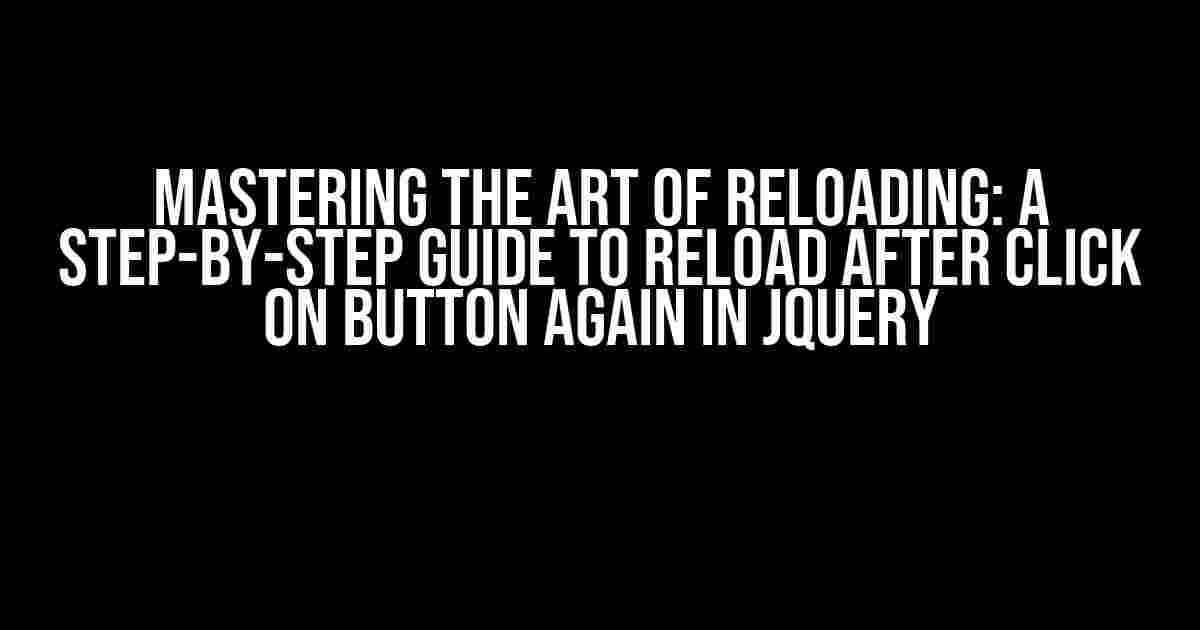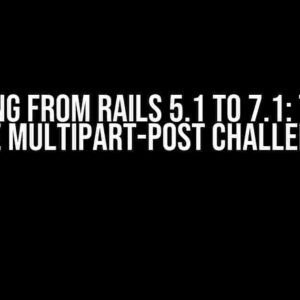Are you tired of refreshing your page manually after clicking a button? Do you want to automate the process and provide a seamless user experience? Look no further! In this comprehensive guide, we’ll dive into the world of jQuery and explore the art of reloading a page after clicking a button again. Buckle up, because we’re about to unleash the power of JavaScript!
Why Reload After Clicking a Button?
In many web applications, clicking a button triggers a series of events that require a page reload to reflect the changes. This could be updating a database, sending an AJAX request, or simply toggling a UI element. Whatever the reason, reloading the page ensures that the user sees the updated content and can interact with the application correctly.
But why do we need to reload the page manually? Can’t we just automate the process and make life easier for our users? That’s where jQuery comes to the rescue! With its powerful event handling capabilities, we can bind a reload function to a button click event, making the user experience smoother and more intuitive.
Understanding the jQuery Syntax
Before we dive into the code, let’s take a moment to understand the jQuery syntax we’ll be using. jQuery is a JavaScript library that simplifies DOM manipulation and event handling. To reload a page, we’ll be using the `location.reload()` method, which is a part of the JavaScript `window` object.
<script>
$(document).ready(function() {
// Your code goes here
});
</script>In the above code, we’re using the `$(document).ready()` function to ensure that our JavaScript code runs only after the HTML document has finished loading. This is a crucial step to avoid any errors or conflicts with other scripts.
Binding the Reload Function to a Button Click
Now that we have a basic understanding of the jQuery syntax, let’s bind the reload function to a button click event. We’ll create a simple HTML button and assign it an ID for easy targeting:
<button id="reload-button">Reload Page</button>In our JavaScript code, we’ll target the button using its ID and bind a click event handler using the `on()` method:
<script>
$(document).ready(function() {
$('#reload-button').on('click', function() {
location.reload();
});
});
</script>In the above code, we’re using the `$(‘#reload-button’)` syntax to target the button element, and then binding a click event handler using the `on()` method. When the button is clicked, the `location.reload()` method is triggered, reloading the page.
Adding a Delay to the Reload Function
Sometimes, you may want to add a delay to the reload function to allow the user to see the changes or to accommodate any animations or loading effects. We can achieve this by using the `setTimeout()` function, which is a part of the JavaScript `window` object:
<script>
$(document).ready(function() {
$('#reload-button').on('click', function() {
setTimeout(function() {
location.reload();
}, 2000); // Delay the reload by 2 seconds
});
});
</script>In the above code, we’re using the `setTimeout()` function to delay the reload by 2 seconds (2000 milliseconds). You can adjust the delay value to suit your needs.
Reload after Clicking a Button Again – Advanced Scenarios
In some cases, you may want to reload the page only after clicking the button again, perhaps to confirm an action or to trigger a specific event. We can achieve this by using a combination of event handling and conditional statements:
<script>
$(document).ready(function() {
var clickedOnce = false;
$('#reload-button').on('click', function() {
if (!clickedOnce) {
clickedOnce = true;
// Perform some action or show a confirmation message
setTimeout(function() {
clickedOnce = false;
}, 2000); // Reset the flag after 2 seconds
} else {
location.reload();
}
});
});
</script>In the above code, we’re using a flag `clickedOnce` to track the button clicks. When the button is clicked for the first time, we set the flag to `true` and perform some action or show a confirmation message. If the button is clicked again before the 2-second delay, the flag is still `true`, and the reload function is skipped. However, if the button is clicked again after the delay, the flag is reset to `false`, and the reload function is triggered.
Common Pitfalls and Troubleshooting
When working with the `location.reload()` method, you may encounter some common pitfalls or issues. Here are some troubleshooting tips to help you overcome them:
- Page reloading indefinitely: Make sure to remove any event listeners or handlers that may be causing the page to reload recursively. Use the `off()` method to detach event handlers when necessary.
- Reload not working in certain browsers: Ensure that you’re using the correct syntax and that the `location.reload()` method is supported in the target browser. You can use a polyfill or a fallback method to handle compatibility issues.
- Reload causing data loss: If you’re using a form or collecting user input, make sure to save the data before reloading the page. You can use AJAX requests or local storage to persist the data.
Best Practices and Optimization
To ensure a seamless user experience and optimal performance, follow these best practices and optimization tips:
- Use caching: Implement caching mechanisms to reduce the load on your server and improve page loading times.
- Optimize images and assets: Compress images and optimize other assets to reduce the overall page weight and improve loading times.
- Minify and compress code: Minify and compress your JavaScript and CSS code to reduce the file size and improve page loading times.
- Use CDN and load balancers: Distribute your content across multiple servers and use load balancers to handle high traffic and improve page loading times.
| Best Practice | Optimization Tip |
|---|---|
| Use caching | Implement caching mechanisms to reduce server load and improve page loading times. |
| Optimize images and assets | Compress images and optimize other assets to reduce page weight and improve loading times. |
| Minify and compress code | Minify and compress JavaScript and CSS code to reduce file size and improve page loading times. |
| Use CDN and load balancers | Distribute content across multiple servers and use load balancers to handle high traffic and improve page loading times. |
Conclusion
In this comprehensive guide, we’ve explored the art of reloading a page after clicking a button again in jQuery. We’ve covered the basics of jQuery syntax, binding the reload function to a button click, adding delays, and advanced scenarios. By following best practices and optimization tips, you can ensure a seamless user experience and optimal performance.
Remember to test your code thoroughly, troubleshoot common issues, and adapt the solutions to your specific use case. With the power of jQuery and JavaScript, you can create dynamic and interactive web applications that delight your users and set your brand apart.
Final Thoughts
As you master the art of reloading, keep in mind the importance of user experience, performance optimization, and code quality. With great power comes great responsibility, so use your newfound knowledge wisely and create web applications that inspire and amaze.
Happy coding, and remember to reload responsibly!
Here are 5 Questions and Answers about “Reload after click on button again in JQUERY” in English, with a creative voice and tone:
Frequently Asked Question
Hey there, JQUERY enthusiasts! Are you stuck with reloading issues after clicking that button again and again? Fear not, friend! We’ve got the answers to your most pressing questions right here.
How do I reload the page after clicking a button in JQUERY?
You can use the `location.reload()` method to reload the page. For example: `$(‘button’).on(‘click’, function(){ location.reload(); });`. This will reload the page after the button is clicked.
Is it possible to reload a specific div instead of the entire page?
Yes, you can use the `load()` method to reload a specific div. For example: `$(‘button’).on(‘click’, function(){ $(‘#myDiv’).load(location.href+’ #myDiv’); });`. This will reload the contents of the `#myDiv` element.
How do I prevent the page from reloading multiple times when clicking the button rapidly?
You can use the `unbind()` method to prevent the button from being clicked multiple times. For example: `$(‘button’).on(‘click’, function(){ $(this).unbind(‘click’); location.reload(); });`. This will unbind the click event after the first click.
Is there a way to delay the page reload after clicking the button?
Yes, you can use the `setTimeout()` function to delay the page reload. For example: `$(‘button’).on(‘click’, function(){ setTimeout(function(){ location.reload(); }, 2000); });`. This will reload the page after a 2-second delay.
How do I reload the page only once after clicking the button, and then disable the button?
You can use a flag to track whether the button has been clicked before. For example: `var clicked = false; $(‘button’).on(‘click’, function(){ if(!clicked){ clicked = true; location.reload(); $(this).prop(‘disabled’, true); } });`. This will reload the page only once and then disable the button.





